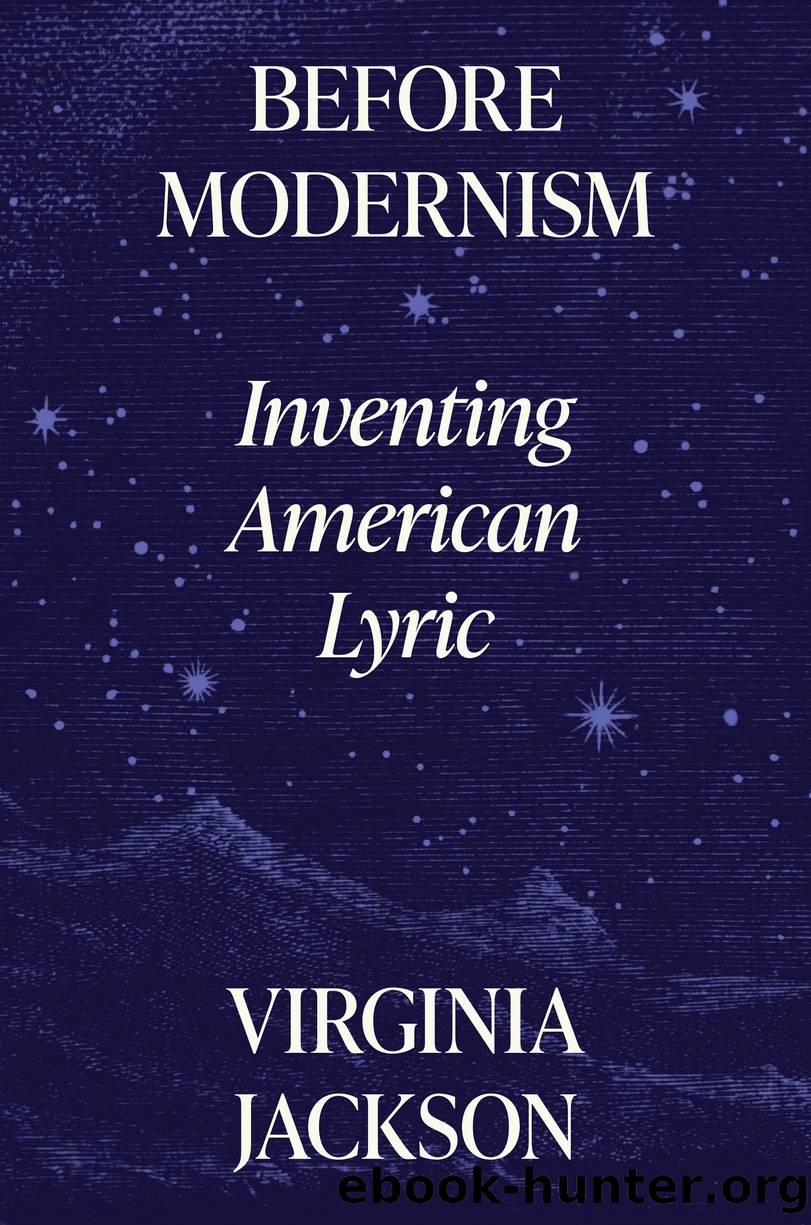Before Modernism by Virginia Jackson;

Author:Virginia Jackson;
Language: eng
Format: epub
Publisher: Princeton University Press
Published: 2022-12-05T00:00:00+00:00
âThy solitary wayâ
My emphasis on Bryantâs creation of a poetics of whiteness is hardly a new idea. Jason Rudy has discovered that in 1828, when the first anthology of English-language poetry was published in South Africa, âthe opening poem of this volume was written not by an English-speaking emigrant to Britainâs Cape Colony but by the American poet William Cullen Bryant.â27 âTo a Waterfowl,â first published in the North American Review in 1818, âwas mistaken as an original of the Cape Colony ⦠thereby establishing Bryant, anonymously, as the first anthologized writer of English poetry in the South African colonyâ (48). The truth is that âTo a Waterfowlâ circulated so extensively in the Anglophone world that its appearance in South Africa is unsurprising (though it is somewhat surprising that it was not recognized as Bryantâs), but as Rudy goes on to point out, it is also not surprising that âBryant reads as a colonial poet because his poems are generic congeriesâ (49). Perhaps Bryant also âreads as a colonial poetâ because he followed British prosodic and stanzaic models to the letter. While Bryantâs colonial genericism and mimetic prosody got him demoted in modern literary histories that valued formal originality, enthusiastic early reviewers recognized the poemâs stanzaic structure as Robert Southeyâs. Yet by 1845, H. T. Tuckerman could write in an essay on âThe Poetry of Bryantâ for The United States Magazine and Democratic Review that âthe very rhythm of the stanzas âto a Waterfowl,â gives the impression of its flight. Like the birdâs sweeping wing, they float with a calm, a majestic cadence to the ear.â28 Apparently, in ten years, âTo a Waterfowlâ had not only become every White Anglophone emigrantâs poem (Rudy also traces publications in Australia, New Zealand, and Canada), but in less than thirty years, it had left its British model behind and was considered its own expressive mimetic form. One of Bryantâs most recent biographers goes as far as to call âTo a Waterfowlâ âa meditative lyricâ characterized by âthe innovative formâ of each quatrainâs âalternating tetrameter and pentameter lines.â29 In 1990, Barbara Packer, in trying to make a case for nineteenth-century American landscape poetry as worthy of Romanticistsâ attention, wrote that âwhat is new about the poem, what made it seem so fresh and original to its first readers, lies ⦠in its form, which manages to break free of the addictive cadences of the blank-verse line or the elegiac quatrain.â30 Yet Bryantâs quatrains remain exactly Southeyâs quatrains, which frame two pentameter lines by a trimeter line at the beginning and another trimeter line at the end of each stanza. Bryantâs âTo a Waterfowlâ begins,
Whither, âmidst falling dew,
While glow the heavens with the last steps of day,
Far, through their rosy depths, dost thou pursue
Thy solitary way?31
Download
This site does not store any files on its server. We only index and link to content provided by other sites. Please contact the content providers to delete copyright contents if any and email us, we'll remove relevant links or contents immediately.
4 3 2 1: A Novel by Paul Auster(11788)
The handmaid's tale by Margaret Atwood(7447)
Giovanni's Room by James Baldwin(6808)
Asking the Right Questions: A Guide to Critical Thinking by M. Neil Browne & Stuart M. Keeley(5356)
Big Magic: Creative Living Beyond Fear by Elizabeth Gilbert(5351)
Ego Is the Enemy by Ryan Holiday(4956)
On Writing A Memoir of the Craft by Stephen King(4662)
The Body: A Guide for Occupants by Bill Bryson(4583)
Ken Follett - World without end by Ken Follett(4443)
Bluets by Maggie Nelson(4261)
Adulting by Kelly Williams Brown(4232)
Eat That Frog! by Brian Tracy(4149)
Guilty Pleasures by Laurell K Hamilton(4116)
White Noise - A Novel by Don DeLillo(3829)
The Poetry of Pablo Neruda by Pablo Neruda(3815)
Fingerprints of the Gods by Graham Hancock(3738)
Alive: The Story of the Andes Survivors by Piers Paul Read(3730)
The Book of Joy by Dalai Lama(3697)
The Bookshop by Penelope Fitzgerald(3619)
